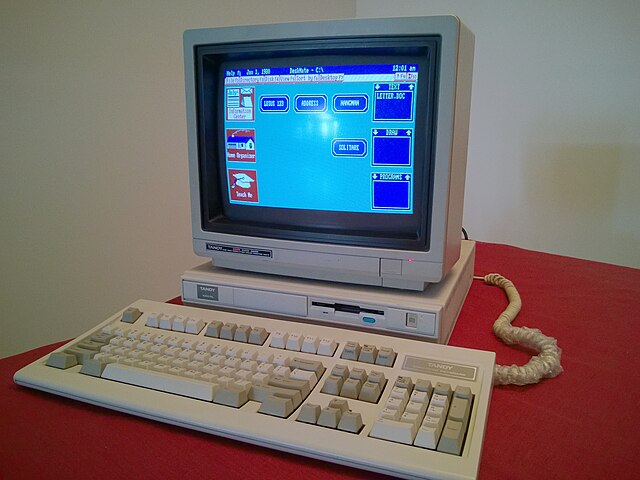The Tandy 1000 is a fascinating piece of computing history. Released in 1983 by Radio Shack, it was a significant step up from the earlier TRS-80 models and a strong competitor in the burgeoning home computer market of the early 80s. Here’s a comprehensive look at the Tandy 1000, covering its history, specs, strengths, weaknesses, and legacy:
History & Development
- Radio Shack’s Response: The Tandy 1000 was Radio Shack’s attempt to directly compete with the Commodore 64 and Apple IIe, which were dominating the home computer scene. They realized the TRS-80 Color Computer wasn’t quite cutting it against these rivals.
- IBM PC Influence: The Tandy 1000 was heavily influenced by the emerging IBM PC. While not IBM PC compatible (initially), it adopted a similar keyboard layout and overall aesthetic. This was a deliberate move to appeal to users who were starting to see the IBM PC as the future of computing.
- Multiple Models: Over its lifespan (1983-1987), the Tandy 1000 went through several revisions, each with improvements:
- Tandy 1000 (1983): The original model.
- Tandy 1000 RL (1984): Added a built-in cassette drive.
- Tandy 1000 SX (1985): Improved graphics, sound, and a more refined design. This is often considered the best of the line.
- Tandy 1000 TX (1986): Included a 3.5″ floppy drive and a faster processor.
- Tandy 1000 SL (1987): A stripped-down, budget model.
Technical Specifications (Vary by Model – focusing on the SX)
- Processor: Intel 8088 running at 4.77 MHz
- RAM: 384KB (expandable to 640KB or more with expansion cards)
- Graphics:
- Video Controller: Tandy Video (PCjr and CGA compatible)
- Resolution: 320×200 or 640×200 pixels
- Colors: 16 colors (though often limited to 8 simultaneously)
- Graphics Modes: Text and graphics modes. The SX had improved graphics capabilities compared to earlier models.
- Sound: Texas Instruments SN76496 sound chip (4 channels) – significantly better than the earlier TRS-80 models.
- Storage:
- Cassette Tape: Standard on most models.
- Floppy Disk Drive: Optional on the original, built-in on later models (RL, TX). Typically 5.25″ floppy disks.
- Keyboard: Full-stroke, typewriter-style keyboard (similar to IBM PC).
- Ports:
- RF output (for connecting to a TV)
- Composite video output (on later models)
- Cassette port
- Joystick ports (2)
- Serial port
- Parallel port
- Expansion slots (for adding memory, disk controllers, etc.)
- Operating System: TRSDOS (Tandy Radio Shack Disk Operating System) – a CP/M derivative.
Strengths of the Tandy 1000
- Excellent Keyboard: Widely praised for its comfortable and responsive keyboard, making it a favorite for writers and programmers. It was a significant improvement over the rubber-key keyboards found on many competitors.
- Good Sound: The AY-3-8912 sound chip provided surprisingly good sound quality for an 8-bit machine, capable of creating music and sound effects that were more sophisticated than many of its rivals.
- Improved Graphics (especially SX): The Tandy 1000 SX offered noticeably better graphics than earlier models, making it more appealing for games and other visual applications.
- Expandability: Expansion slots allowed users to add more memory, disk controllers, and other peripherals, extending the computer’s capabilities.
- Price: Generally more affordable than the Apple IIe, making it accessible to a wider range of users.
- Strong Software Library: While not as extensive as the Commodore 64 or Apple II, the Tandy 1000 had a respectable library of games, educational software, and productivity applications.
- Built-in BASIC: Included a BASIC interpreter for programming.
Weaknesses of the Tandy 1000
- Not IBM PC Compatible (initially): This was a major drawback as the IBM PC was becoming the dominant standard. Later attempts to add PC compatibility were not entirely successful.
- Limited Color Palette: While it had 16 colors, often only 8 could be displayed simultaneously, limiting the visual richness of some games and applications.
- TRSDOS: While functional, TRSDOS wasn’t as widely supported or as feature-rich as other operating systems like DOS.
- Competition: Faced fierce competition from the Commodore 64, Apple IIe, and later, the IBM PC.
- Radio Shack’s Marketing: Radio Shack’s marketing sometimes lacked the sophistication of its competitors, hindering its overall market penetration.
Software & Games
The Tandy 1000 had a decent software library, including:
- Games: Forbidden Forest, Lode Runner, Manic Miner, Jet Set Willy, Knight Lore, Bubble Bobble, Gauntlet (ported versions).
- Productivity: Word processing, spreadsheets, database management software.
- Educational: Typing tutors, math programs, language learning software.
- Programming: BASIC interpreter, assembly language tools.
- Desktop Publishing: Some early desktop publishing software was available.
Legacy & Current Status
- Cult Following: The Tandy 1000 has a dedicated cult following among retro computing enthusiasts.
- Emulation: Emulators like MAME and TRS80GP allow you to run Tandy 1000 software on modern computers.
- Preservation: Efforts are underway to preserve Tandy 1000 software and hardware.
- Collectibility: Tandy 1000 computers, especially the SX model, are collectible items.
- Influence: The Tandy 1000 helped to popularize home computing and paved the way for future generations of computers.
Where to find more information
- TRS-80.org: http://www.trs-80.org/ – A comprehensive resource for all things TRS-80 and Tandy.
- Wikipedia: https://en.wikipedia.org/wiki/Tandy_1000
- Vintage Computer Federation: https://vintagecomputer.net/
In conclusion, the Tandy 1000 was a capable and well-designed 8-bit home computer that offered a compelling alternative to its competitors. While it ultimately lost the battle for market dominance, it remains a fondly remembered and historically significant machine. Its excellent keyboard, good sound, and expandability made it a favorite among many users, and its legacy continues to live on through the efforts of retro computing enthusiasts.
